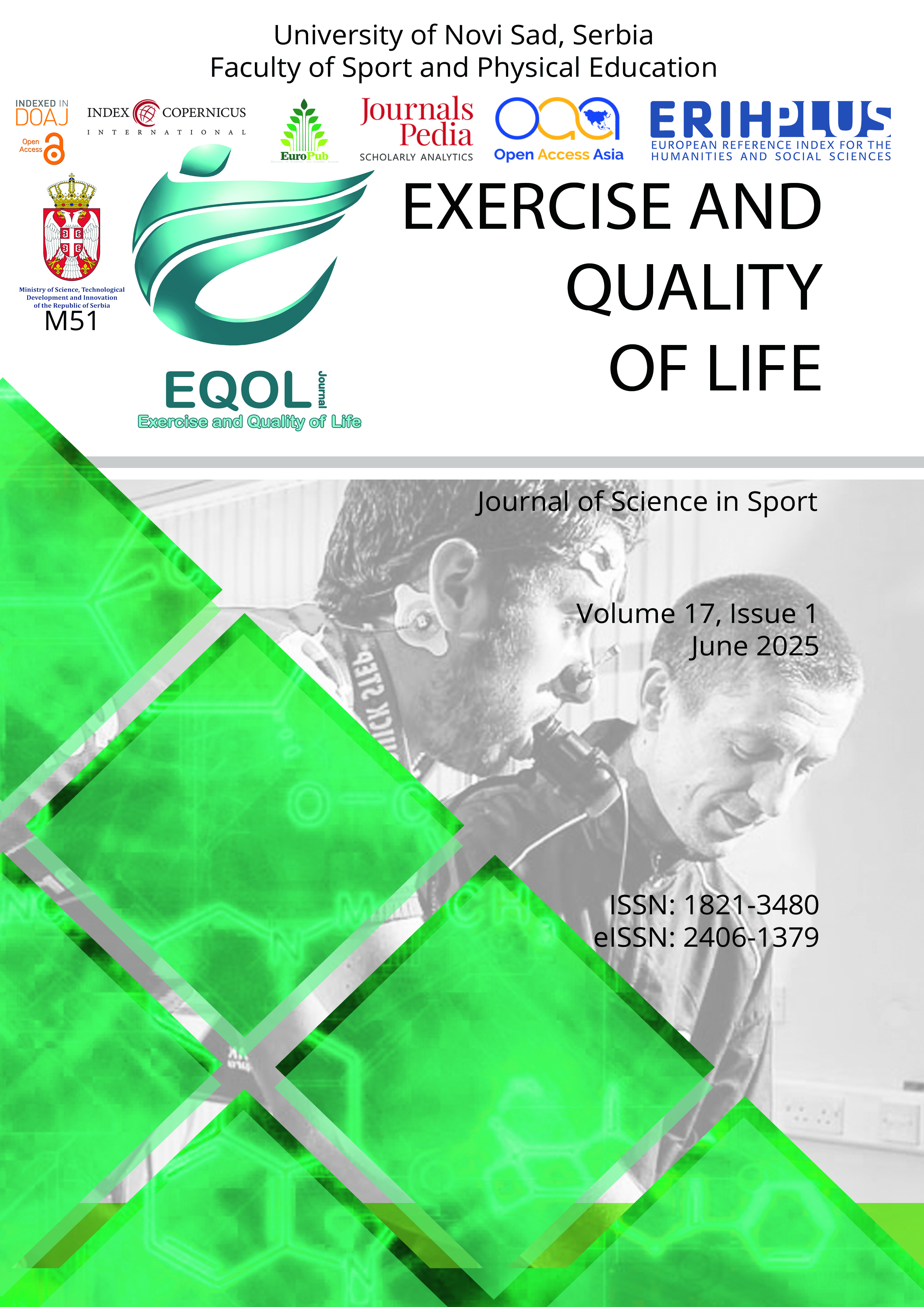Current issue

Volume 17, Issue 1, 2025
Online ISSN: 2406-1379
ISSN: 1821-3480
Volume 17 , Issue 1, (2025)
Published: 15.06.2025.
Open Access
All issues
Contents
14.06.2022.
Original scientific paper
Motor coordination and weight status in children according to area of residence
A good understanding of potential differences in motor coordination and weight status in children from rural and urban areas may advance targeted measures implemented by experts in the field of sports and physical education. This research study is focused on investigating differences in the total motor coordination score and weight status in 70 children aged (7 to 8) living in different residential areas within the territory of the city of Šabac, Republic of Serbia (35 urban and 35 rural areas). The Körperkoordinations Test für Kinder battery of tests was used for the assessment of the overall motor coordination. By application of t-test for independent samples, the obtained results indicate that there are statistically significant differences in the majority of the applied motor tests (walking backward, p=0.000; hop for height on one leg, p=0.033; side jumps, p=0.002), as well as in the total motor coordination scores (p=0.000) in favor of the children from rural environments. The weight status of children indicates no statistically significant differences between the two groups (p=0.376).
Živan Milošević, Filip Sadri, Ivo Sadri, Marijana Sinđić, Maja Batez
15.06.2021.
Original scientific paper
Relationship between cognitive abilities and manual coordination and balance in preschool children
Background: The purpose of this research was to investigate the relationship between cognitive abilities and manual coordination and balance in preschool children. Methods: The sample consisted of 41 preschool children aged 6.4±0.8 on average, of both sexes (30 boys and 11 girls). On top of their regular preschool activities, the children attended a school of sports for preschool children - multisport activities and exercises, twice a week. The sample of measuring instruments comprised 4 motor tests (One-leg stand test, Mann’s test, Finger to nose, Front raises) and 2 cognitive tests (Raven's Colored Progressive Matrices, Cognitive Assessment System). Data was analyzed by applying Linear and Binary logistic regression analysis. Results: Based on the results of the research, one may conclude that there is a statistically significant relation between cognitive abilities and manual coordination in the tested sample of preschool children. The defined predictor system, which consisted of cognitive tests, showed a significant relationship with the hand coordination test, which was assessed by the Finger to Nose test with the eyes closed. A significant contribution to the established relation was given by the G factor estimated by Raven's colored progressive matrices. Conclusions: Physical activities contribute to the development of motor skills and thus to the development of some cognitive abilities in children, which is of great importance for their further development.
Filip Sadri, Ivo Sadri, Željko Krneta, Jovana Trbojević Jocić, Maja Batez
01.06.2015.
Original scientific paper
Postural and nutritional status of students from urban and suburban environment
Monitoring postural and nutritional status is very useful for sheding light on problems in the process of growth and development of children. The aim of this study was to determine the difference in postural status of younger-aged school children of urban and suburban environment according to their nutrition. Research sample included 497 male and female pupils from Novi Sad (251) and suburban environment (246), aged 11 and 12. Postural status was assessed using the method of somatoscopy and nutrition level with BMI calculator. The relation between the category of nutrition and the incidence of postural disorders was tested using a chi-square test at the significance level of p≤0.05. The results show a statisticaly significant difference in pupils in terms of sagittal spine plane, chest and feet according to their nutritional status. Lordotic bad posture (p=0.008), right lumbar scoliosis (p=0.007), high arch foot (p=0.043) and flat feet (p=0.007) were the most frequent postural disorders in the normal weight pupils. The incidence of kypholordotic posture (p=0.005) and flat-chest (p=0.002) was significantly higher among pupils from suburban environment. The incidence of kypholordotic posture (p=0.012) was significantly higher in over-nourished pupils from the suburban environment. Postural disorders and nutritional abnormalities significantly increase in children of the urban and suburban environment. Therefore, it is necessary to provide adequate conditions and include them in an organized physical exercise in order to prevent the occurrence of postural disorders and disorders of the nutritional status.
Ksenija Radaković, Branka Protić-Gava, Tijana Šćepanović, Mića Radaković, Maja Batez, Maja Batez, Milan Kojić























